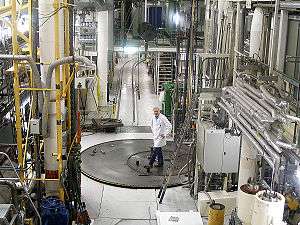Halden Reactor
The Halden Reactor[1] is a 25MW nuclear reactor located in Halden, Norway and dedicated for research. The reactor became operative in 1958, and is operated by the Institute for Energy Technology (IFE). In October 2016 media said that it is expected to close now, without saying what year it will reopen.[2]. In June 2018, the board of directors of Norway's Institute for Energy Technology (IFE) has decided to close the Halden Reactor permanently and to start its decommissioning. The board will not apply to extend its operating licence, which expires in 2020, and the reactor, which is currently shut down due to a safety valve failure, will not be restarted. [3]

The reactor is a Boiling water reactor (BWR) moderated by heavy water.[4] The reactor is used for safety-focussed research into materials, fuel burnup, and fuel behaviour in prolonged operating conditions in co-operation with organizations from 19 countries.[5]
In August 2019 IFE started an investigation into alleged scientific misconduct in historic Halden Reactor projects involving the possible alterations of research results. Since 2016 IFE has worked to improve the safety culture and processes at Halden.[6] An independent investigation found that the results of several nuclear fuel tests carried out between 1990 and 2005 had been fabricated, and the false results had been supplied to a number of nuclear organisations internationally.[7]
In 2020 it was estimated dismantling the Halden and Kjeller research reactors and restoring the sites to unrestricted use will cost about NOK20 billion (US$2 billion) and take 20 to 25 years.[8]
Incidents
The research reactor suffered on 24 October 2016 1:45 pm a small leakage of radioactive Iodine. No health risk or danger to the environment outside the facility was expected by the NRPA-authority. The reactor was already shut down at the time for routine maintenance.[9] On 25 October the Norwegian Institute for Energy Technology (IFE), announced that the leak had been contained. No injuries were reported. The personnel at the plant had only been exposed to a small dosage of radiation.[10]
References
- "Archived copy". Archived from the original on 2018-07-30. Retrieved 2014-06-07.CS1 maint: archived copy as title (link)
- https://www.nrk.no/ostlandssendingen/permitterer-127-ansatte-og-stenger-atomreaktorene-1.13172744
- http://www.world-nuclear-news.org/C-Halden-Reactor-to-be-decommissioned-28061802.html
- Holtebekk, Trygve; Guttormsen, Magne. "Haldenreaktoren". In Henriksen, Petter (ed.). Store norske leksikon (in Norwegian). Oslo: Kunnskapsforlaget. Retrieved 19 March 2011.
- http://www.oecd-nea.org/jointproj/halden.html
- "Norway investigates possible past misconduct in reactor projects". Nuclear Engineering International. 12 August 2019. Retrieved 26 August 2019.
- Digges, Charles (3 June 2020). "Bellona wants answers about data fabrication scandal at Norwegian research reactor". Bellona. Retrieved 4 June 2020.
- ""Norwegian reactor dismantling to cost almost USD2 billion". World Nuclear News. 18 May 2020. Retrieved 20 May 2020.
- WNN (25 October 2016) Radioactive release from Norwegian research reactor
- RT (25 October 2016) Norway nuclear reactor suffered radioactive leak – authority